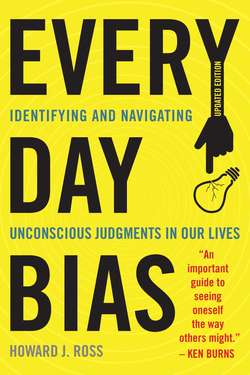Читать книгу Everyday Bias - Howard J. Ross - Страница 7
На сайте Литреса книга снята с продажи.
Is There Only One Kind of Bias?
ОглавлениеIs bias basically something we have or don’t have, or are there different kinds of biases? Amy Cuddy, at Harvard Business School; Susan Fiske at Princeton University; and Peter Glick, at Lawrence University in Appleton, Wisconsin, studied these distinctions and created a valuable map for looking at the way we process bias.[10]
Cuddy, Fiske, and Glick were able to identify two distinct forms of bias. The first is bias based on warmth. In their terms, “our warmth scales have included good-natured, trustworthy, tolerant, friendly, and sincere.”[11]
In short, do you consider the personal likable? Is it somebody you feel comfortable being around? On the other hand, the second form is bias based on competence, which they classify as “capable, skillful, intelligent, and confident.”[12] Looking at bias in this way can be very helpful. We may have inherent biases about groups of people, biases which are very strong, but are very different between the different groups. In extensive research, Cuddy, Fiske, and Glick found there were some groups people tended to respond to with a low degree of both warmth and competence (e.g., welfare recipients, homeless people, poor people, and Arabs). Others we may feel a high degree of warmth toward, but not see as very competent (e.g., the elderly and people with physical or mental disabilities). Still others we may see as very competent, but not feel very much warmth toward at all (e.g., Asians, rich people, and Jews). And finally, there are those for whom we feel a high level of warmth, and a high level of competence (e.g., housewives, Christians, middle class Americans).[13] How we feel about each of these groups might yield very different behaviors.
Warmth seems to be the primary dimension in terms of how we respond to people. We are more likely to first emotionally respond to whether or not we like someone, and only secondarily respond to whether or not we believe they are competent. Cuddy and her study associates suggest this results in more active facilitation. They wrote that “perceived warmth predicts active behaviors: groups judged as warm elicit active facilitation (i.e., help), whereas those judged as lacking warmth elicit active harm (i.e., attack).”[14]
They also reported that “the competence dimension, being secondary (because it assesses others’ capability to carry out intentions), predicts passive behaviors: groups judged as competent elicit passive facilitation (i.e., obligatory association, convenient cooperation), whereas those judged as lacking competence elicit passive harm (i.e., neglect, ignoring).”[15]
So the way the bias plays out may be very different, depending upon which dimension elicits a reaction from us. Consider whether you are dealing with somebody who is elderly, or has a physical disability, both types that tested in the high warmth, low competence dimension of the study. You may feel very warmly and loving toward them, but you may tend to treat them as being less competent than they are in reality.
Deb Dagit, Diversity Consultant and former Chief Diversity Officer
As a four-foot-tall woman who either walks with a cane or uses a wheelchair, it is not unusual for people to express their surprise when they meet me.
I often find people intending to make sincere compliments that can be quite off-putting, like “When I first met you I was surprised to see that you were handicapped, but now I don’t even think about you being a person with special needs.” I would much prefer “person with a disability,” which doesn’t identify me as my disability. Others say things such as, “You must work for a really special company if they would hire someone like you in such a visible role.” Some people continue to ask when I will be getting well enough to walk again, rather than be in my wheelchair.
Most people with disabilities consider their disability to be an important and valued aspect of their identity that does not need to be overlooked or forgotten in order to make us more acceptable and competent.
I remember leading a workshop for a client many years ago in St. Louis. We were conducting a three-day training in a hotel and had arranged to have several wheelchairs available for the participants to use at various times as they negotiated the hotel. Obviously we were not pretending that this was the same as having a permanent disability, but we found that it could make a great impact upon people to consciously see what it was like to negotiate both the physical environment and being with people. One of the participants took the wheelchair overnight, and called for room service for breakfast in the morning. The participant reported that when the room service waiter came with the food in the morning, he seemed visibly surprised to find somebody with a wheelchair in a room that was not handicap accessible. He proceeded to place the tray on the table, remove the chrome food cover, and started to cut the participant’s food! The participant was stunned and asked the waiter what he was doing. The waiter said he was only trying to be of help. This example shows how we can feel very warmly toward people and still demonstrate behavior that is patronizing and demonstrates a judgment of less competence.
On the other hand, you may have enormous respect for someone’s competence, thinking them extremely capable, and yet just not like them very much. This may result in a completely different kind of bias. You may not choose them to be on a team you are putting together to work on a project, or not invite them to lunches or other business gatherings, and in doing so affect their ability to be successful.
